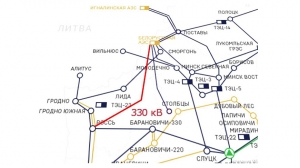Belarusian nuclear power plant gets seventh link to power grid

MINSK, 5 October (BelTA) – The Belarusian nuclear power plant has received its seventh link to the national power grid – a high-voltage electricity transmission line has been built between the nuclear power plant and the 330kV power substation Ross, BelTA learned from the national electric company Belenergo.
The 250km-long power line will enable electricity transmission from the Belarusian nuclear power plant to the western part of the country's power grid in the future. It is the longest 330kV power line in Belarus' power grid.
The reliability of the part of the Belarusian nuclear power plant's switchgear that is connected to this power line and the equipment of the power line are being comprehensively tested now. The new high-voltage power line will enable optimal operation of the power grid before and after units of the Belarusian nuclear power plant are commissioned.
BelTA reported earlier that six other overhead high-voltage power lines to connect the Belarusian nuclear power plant with nodes of the country's power gird (330kV substations) have been commissioned earlier. These power lines are securely protected against various kinds of short-circuit failures.
In the course of turning on the high-voltage power lines that connect the Belarusian nuclear power plant with the power grid the dispatch personnel as well as personnel of other divisions had to tackle complicated tasks, including unconventional ones. Temporary power lines were set up, working parameters of relay protection equipment were recalculated in order to ensure reliable operation of the power grid during constant changes. All of it was done in order to keep consumers properly supplied with electricity while maintaining optimal operation of the power grid.
The Belarusian nuclear power plant is being built near Ostrovets, Grodno Oblast using the Russian design AES-2006 featuring two VVER-1200 reactors with the total output capacity of 2,400MW. The Russian state nuclear industry corporation Rosatom is the general contractor. The reactor power startup of the first unit is scheduled for 7 November 2020. The second unit is supposed to be commissioned in 2022.













